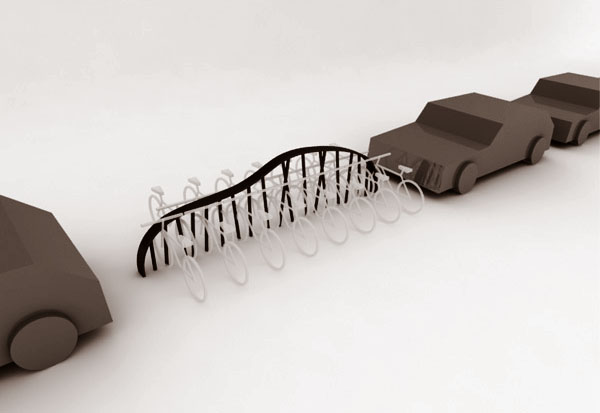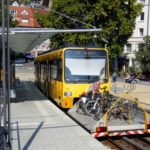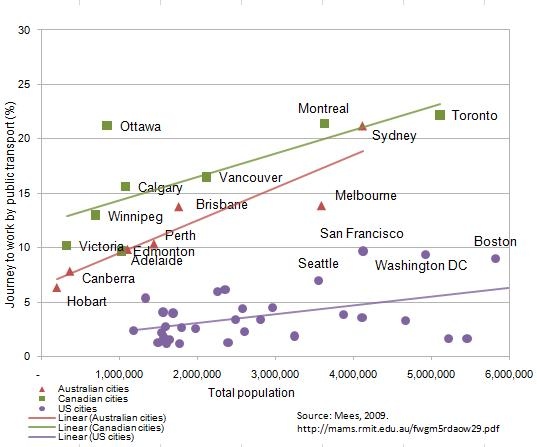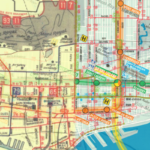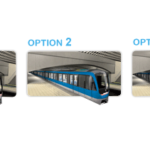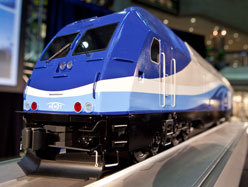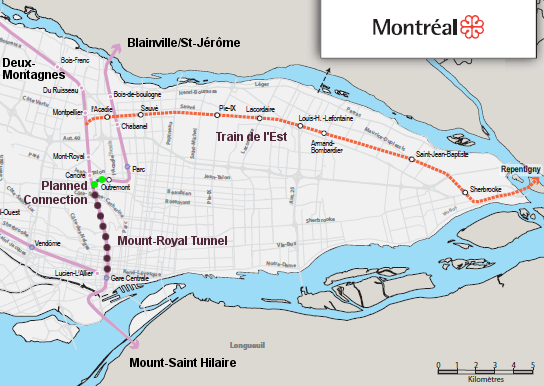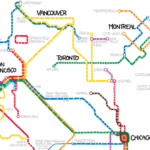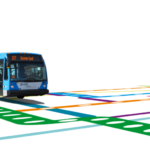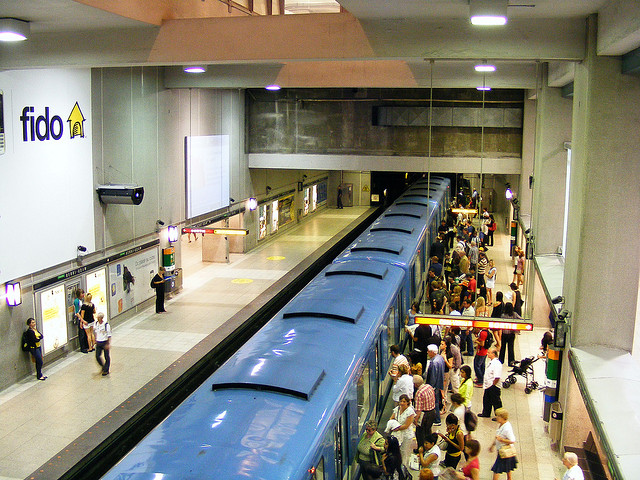
Berri Metro station - The system is at full capacity now, new cars would really be nice - cc flickr abdallahh
Now it’s official. Instead of trying to get the new Montreal metro cars at market value, Quebec just confirmed that the contract is directly going to be given to Bombardier. Without a bidding process. This comes just a few days after the government asked the STM to delay the opening of the bidding process, so that the province can pass a law that would allow the STM to directly negotiate with Bombardier/Alstom based on their 2008 bid.
The Montreal blog fagstein offers this timeline:
- May 2006: The Quebec government announces it’s going to hand a $1.2-billion contract to build new metro cars to Bombardier without putting it out to tenders. It reasons that Bombardier is the only company that can build the cars in Quebec on rubber wheels. Competitor Alstom immediately points out that it could have done the same.
- June 2006: Alstom sues.
- January 2008: A judge rules in favour of Alstom, which he says has a right to bid on the contract.
- February 2008: The Quebec government starts from scratch, opening up bidding for the contract.
- November 2008: Bombardier and Alstom submit a joint bid on the contract. Being the only bidders, they quickly get it.
- November 2009: The Quebec government decides to double the scope of the contract from 340 to 765 cars, replacing not just the oldest cars but the entire fleet.
- December 2009: Chinese company ZhuZhou comes out of nowhere and demands to be able to bid on the new contract. ZhuZhou promptly sues. A Spanish company, CAF, does the same.
- January 2010: A judge rules that because of the expanded scope of the contract, these new companies should be allowed to bid. The STM puts out a call for interest, but competitors argue it’s rigged to ensure that Bombardier-Alstom gets the contract. ZhuZhou says it will sue.
- March 2010: Both China’s ZhuZhou and Spain’s CAF express interest in bidding for the expanded metro contract.
- May 2010: Bombardier-Alstom sues.
- June 2010: A judge rules against Bombardier-Alstom, saying the STM can put out a public call for bids on the expanded metro contract.
- July 2010: The STM decides to start from scratch for a third time, opening up bidding for the expanded contract
- October 2010: The Quebec government decides it will start from scratch a fourth time, and just hand over a $1.3-billion contract without putting it up for bids. It cites the urgency of acquiring new cars. CAF says it will sue.
He also offers a projection on what will happen next, which can be found in his article here.
It already is very fishy how Alstom first sued to get an open bidding process on the cars — the whole point of which is to get a market value deal for the taxpayer — but then suddenly joined with Bombardier just to undermine that exact same process.
It is also strange that the call for bids at that time had restrictions that would only allow Alstom and Bombardier to bid. It required that any bidding company had rubber tyre metro technology running somewhere for at least 5 years. This made the whole bidding process moot. That’s why Spanish CAF sued to begin with, to get a chance to bid as well.
Now CAF, desperate to get the contract, just offered to build the metro cars for only 1.4$ million dollars – almost the same amount that they got paid by the Santiage metro System to build basically the same metro cars. In comparison, Bombardier/Alstom is currently asking for 2.6$ million. This is down from originally asking 3.3$ million; just the threat of an open bidding process lowered the price.
But That’s still 1.22$ billion vs caf’s 670$ million offer for the whole order – 550$ million less. And this being a continuation of the 2008 bid, before the order get expanded to the whole fleet, the difference would grow as the STM would exercise the option to order more cars at the same prize. The difference could grow to over 1$ billion dollars.
Now why would the government push this through if it represents such a huge burden on the tax payer?
Cars = Too old?
The claim the Charest government makes is that the metro car issue is becoming urgent, that they cars not to replaced soon. And sure, the oldest cars are from 1963, almost 50 years old. But just this summer the STM confirmed that the metro cars are old but safe.
The maintenance costs will grow in the next couple of years, but it seems hard that they will grow to hundreds of millions of dollars. At the same time I wonder how many months the bidding process will delay the delivery of the cars. My guess is that the final negotiations, engineering and testing will overshadow the bidding time, anyway.
CAF = Unreliable?
The claim on the side of Bombardier/Alstom is that their technology is much more reliable, that caf simply doesn’t have the expertize.
“There’s no way that (Montrealers) should be the STM’s guinea pigs, with all the risks that it entails, including the maintenance of these cars for the next 40 years”, they claim.
But CAF is building rubber tyred metro cars for Santiago, and they also hired former Bombardier employees. Surely that should give them at least some credibility.
Another claim is that caf won’t build most of the cars in Quebec. Yet, a requirement of bidding is that 60% of the work has to be done in Quebec either way. In any case this is a requirement that should be tested by the open bidding process, and not by claims of the competitor, or the gut feeling of some politicians.
Bombardier = good for Quebec?
Quebecers have positive feelings towards Bombardier. The company was found in Quebec, started as a small shop in the Eastern Townships. It built the first metro cars. It creates jobs. Quebecers have dear feelings towards the company, they are one of ‘us’.
But in the end of the day Bombardier is just a company, a multi-national one, that answers to its stock holders and not the people of Quebec. It is not a guarantor of jobs in Quebec. This summer the company just showed that when it cut back on jobs in the plant where it intended to build the metro cars, and threatened to shut it down of they wouldn’t get the contract.
At the same time Bombardiers is building rolling stock all over the world. Bombardier doesn’t really care about Quebec, maybe then they would offer the taxpayers a better deal. At the same time, given that caf would have to assemble the metro cars in Quebec, the Spanish bidder would have to open a plant here as well, anyway. So the contract will create jobs in this province, no matter who is getting it.
Contract with Bombardier = Votes?
There is another angle to the story. The decision to fast-track the metro contract might be due to electoral goals. The riding of Kamarouska-Temiscouata, where the Bombardier plant is located, is about to have a by-election to replace national assembly member Claude Bechard, who passed away on September 8th. Surely saving a thousand jobs in that region will gain the Liberals some support, and they might win the seat.
If that is actually the case as some suggest, then this will be a very expensive way of buying the seat. As an article in ‘argent’ puts it: $ 1 million per vote.
Whatever the actual reason is for this maneuver, something is seriously wrong here. This whole bungled deal, despite going on for years, has not resulted in the best possible deal. CAF is not amused, and even the Spanish Ambassador is getting involved.
It is ironic that this comes just as Quebec is outraged over a trolling MacLean’s article proclaiming Quebec to be “the most corrupt province”. Even the Quebec government demanding an apology. Now the same government is mysteriously giving Bombardier an over-expensive contract. And the taxpayers are going to have to pay.



